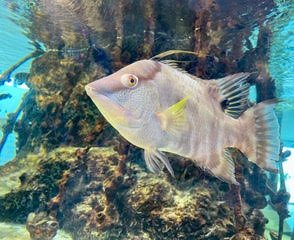Hogging the Limelight: The Hogfish
by Nicole McKenna
Hi, I’m Nicole! I’m an Environmental Education Intern at the Tampa Bay Watch Discovery Center. Today we’re going to be learning a little bit more about a special fish, called the Hogfish!
If you’ve been to the Discovery Center, you’ve likely seen the hogfish. It’s a vibrant and unique fish that steals the show, but there’s more to this species than you see at first glance.
The hogfish is commonly found in warmer waters, such as the Caribbean and the Gulf of Mexico. They received their name for their “hoglike” snout, which they use to search the sand for their favorite foods, crustaceans and mollusks. They can be found near sandy bottoms and coral reefs, in deep or shallow water.
What is so special about the hogfish isn’t evident at first, but watch them for a few minutes and you will see… they can change color! This is really helpful for camouflaging themselves on reefs and the sandy bottoms they call home. Their color generally varies from white to a dark red color, depending on their surrounding environment.
Hogfish are thought to be able to change color by sensing light through their skin, like how a Squid or Chameleon is able to camouflage into their environment. One Biologist, Lori Schweikert, found that hogfish could even camouflage themselves after they die. This color changing process isn’t totally understood, but is thought to involve chromatophores, which are cells that contain pigment.
Overall, hogfish have a really cool adaptation that allows them to camouflage themselves from predators. Known as one of the “Chameleons of the Sea” they definitely live up to their name! I hope you have learned a little bit more about the hogfish, and have a chance to see them at the Discovery Center or possibly even in Tampa Bay.

